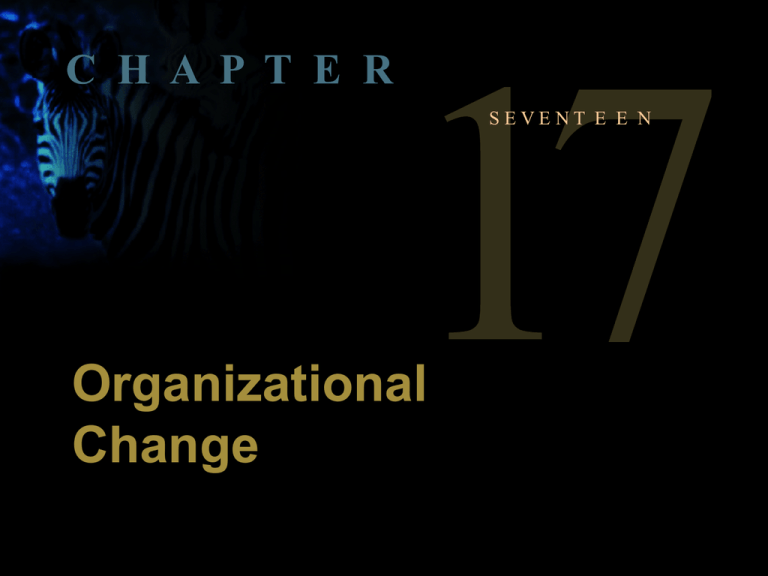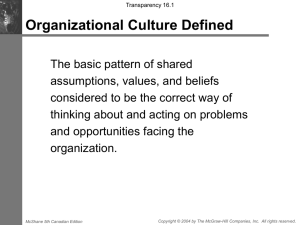
C H A P T E R
SEVENT E E N
.
Organizational
Change
McShane 5th Canadian Edition
1
Copyright © 2004 by The McGraw-Hill Companies, Inc. All rights reserved.
Change at Telus Corp.
Telus, the Vancouver-based
telecommunications firm, has
been forced by deregulation
and new technology to
dramatically change its
culture and practices. “I do
think the employees of this
organization understand the
need for change,” says CEO
Darren Entwistle (shown).
McShane 5th Canadian Edition
2
CP/Kevin Frayer
Copyright © 2004 by The McGraw-Hill Companies, Inc. All rights reserved.
Force Field Analysis Model
Restraining
Forces
Desired
Conditions
Restraining
Forces
Driving
Forces
Restraining
Forces
Current
Conditions
Driving
Forces
Driving
Forces
Before
Change
McShane 5th Canadian Edition
During
Change
3
After
Change
Copyright © 2004 by The McGraw-Hill Companies, Inc. All rights reserved.
Resistance to Change
Direct Costs
Saving Face
Fear of the Unknown
Forces for
Change
Breaking Routines
Incongruent Systems
Incongruent Team Dynamics
McShane 5th Canadian Edition
4
Copyright © 2004 by The McGraw-Hill Companies, Inc. All rights reserved.
Creating an Urgency for Change
• Inform employees about driving forces
• Most difficult when organization is doing
well
• Must be real, not contrived
• Customer-driven change
– Adverse consequences for firm
– Human element energizes employees
McShane 5th Canadian Edition
5
Copyright © 2004 by The McGraw-Hill Companies, Inc. All rights reserved.
Reducing Restraining Forces at Unilever
Gary Calveley (right) brought in
team coaches to train
employees throughout the
process of changing Unilever’s
Elida Faberge factory into
Europe’s best factory. A
theatrical production helped to
communicate the changes that
Calveley was trying to achieve
through coaching.
McShane 5th Canadian Edition
6
Dean Smith/The Camera Crew
Copyright © 2004 by The McGraw-Hill Companies, Inc. All rights reserved.
Minimizing Resistance to Change
Communication
• Highest priority and first
strategy for change
• Improves urgency to
change
• Reduces uncertainty (fear
of unknown)
• Problems -- time
consuming and costly
McShane 5th Canadian Edition
7
Copyright © 2004 by The McGraw-Hill Companies, Inc. All rights reserved.
Minimizing Resistance to Change
Communication
Training
• Provides new knowledge
and skills
• Includes coaching and
action learning
• Helps break old routines
and adopt new roles
• Problems -- potentially
time consuming and costly
McShane 5th Canadian Edition
8
Copyright © 2004 by The McGraw-Hill Companies, Inc. All rights reserved.
Minimizing Resistance to Change
Communication
Training
Employee
Involvement
• Increases ownership of
change
• Helps saving face and
reducing fear of unknown
• Includes task forces,
search conferences
• Problems -- timeconsuming, potential
conflict
McShane 5th Canadian Edition
9
Copyright © 2004 by The McGraw-Hill Companies, Inc. All rights reserved.
Minimizing Resistance to Change
Communication
Training
Employee
Involvement
Stress
Management
• When communication,
training, and involvement
do not resolve stress
• Potential benefits
– More motivation to change
– Less fear of unknown
– Fewer direct costs
• Problems -- timeconsuming, expensive,
doesn’t help everyone
McShane 5th Canadian Edition
10
Copyright © 2004 by The McGraw-Hill Companies, Inc. All rights reserved.
Minimizing Resistance to Change
Communication
Training
Employee
Involvement
Stress
Management
Negotiation
McShane 5th Canadian Edition
• When people clearly lose
something and won’t
otherwise support change
• Influence by exchange-reduces direct costs
• Problems
– Expensive
– Increases compliance, not
commitment
11
Copyright © 2004 by The McGraw-Hill Companies, Inc. All rights reserved.
Minimizing Resistance to Change
Communication
Training
• When all else fails
Employee
Involvement
• Assertive influence
Stress
Management
• Firing people -- radical
form of “unlearning”
Negotiation
Coercion
McShane 5th Canadian Edition
• Problems
– Reduces trust
– May create more subtle
resistance
12
Copyright © 2004 by The McGraw-Hill Companies, Inc. All rights reserved.
Refreezing the Desired Conditions
Realigning organizational systems and team
dynamics with the desired changes
– Alter rewards to reinforce new behaviours
– Feedback systems
• Help employees learn how they are doing
• Provide support for the new behaviour patterns
McShane 5th Canadian Edition
13
Copyright © 2004 by The McGraw-Hill Companies, Inc. All rights reserved.
Strategic Vision & Change at CHC
CHC Helicopter Corp.’s four
strategic principles have helped
its employees adapt to rapid
growth at the St. John’s, Nfld.
firm. These principles include
safety first, quality service,
teamwork, and profitable
Courtesy of CHC Helicopter Corp.
McShane 5th Canadian Edition
growth.
14
Copyright © 2004 by The McGraw-Hill Companies, Inc. All rights reserved.
Strategic Vision & Change
• Need a vision of the desired
future state
• Minimizes employee fear of
the unknown
• Clarifies role perceptions
Courtesy of CHC Helicopter Corp.
McShane 5th Canadian Edition
15
Copyright © 2004 by The McGraw-Hill Companies, Inc. All rights reserved.
Change Agents
• Anyone who possesses
enough knowledge and
power to guide and facilitate
the change effort
• Change agents apply
transformational leadership
–
–
–
–
Courtesy of CHC Helicopter Corp.
McShane 5th Canadian Edition
16
Help develop a vision
Communicate the vision
Act consistently with the vision
Build commitment to the vision
Copyright © 2004 by The McGraw-Hill Companies, Inc. All rights reserved.
Successfully Diffusing Change
• Successful pilot project
• Receives visibility
• Top management support
• Labour union involvement
• Diffusion strategy described clearly
• Pilot project people moved to other
areas
McShane 5th Canadian Edition
17
Copyright © 2004 by The McGraw-Hill Companies, Inc. All rights reserved.
Action Research Philosophy
• Change needs both action and research
focus
• Action orientation
– Solve problems and change the
organizational system
• Research orientation
– Concepts guide the change
– Data needed to diagnose problem, identify
intervention, evaluate change
McShane 5th Canadian Edition
18
Copyright © 2004 by The McGraw-Hill Companies, Inc. All rights reserved.
Action Research Process
Establish
ClientConsultant
Relations
Diagnose
Need for
Change
Introduce
Change
Evaluate/
Stabilize
Change
Disengage
Consultant’s
Services
McShane 5th Canadian Edition
19
Copyright © 2004 by The McGraw-Hill Companies, Inc. All rights reserved.
Appreciative Inquiry at Hunter Douglas
The Hunter Douglas Window
Fashions Division in Colorado
relied on appreciative inquiry
as well as a search conference
to create a collective vision, reinstill a sense of community
among employees, and build
leadership within the company.
McShane 5th Canadian Edition
20
Courtesy of Amanda Trotsen-Bloom
Copyright © 2004 by The McGraw-Hill Companies, Inc. All rights reserved.
Appreciative Inquiry Philosophy
• Directs the group’s attention
away from its own problems
and focuses participants on
the group’s potential and
positive elements.
• Reframes relationships
around the positive rather
than being problem oriented
McShane 5th Canadian Edition
21
Courtesy of Amanda Trotsen-Bloom
Copyright © 2004 by The McGraw-Hill Companies, Inc. All rights reserved.
Appreciative Inquiry Process
Discovery
Dreaming
Designing
Delivering
Discovering
the best of
“what is”
Forming
ideas about
“what might
be”
Engaging in
dialogue
about “what
should be”
Developing
objectives
about “what
will be”
McShane 5th Canadian Edition
22
Copyright © 2004 by The McGraw-Hill Companies, Inc. All rights reserved.
Parallel Learning Structure Philosophy
• Highly participative social structures
• Members representative across the
formal hierarchy
• Sufficiently free from firm’s constraints
• Develop solutions for organizational
change which are then applied back into
the larger organization
McShane 5th Canadian Edition
23
Copyright © 2004 by The McGraw-Hill Companies, Inc. All rights reserved.
Parallel Learning Structures
Parallel
Structure
McShane 5th Canadian Edition
Organization
24
Copyright © 2004 by The McGraw-Hill Companies, Inc. All rights reserved.
Cross-Cultural and Ethical Concerns
• Cross-Cultural Concerns
– Linear and open conflict assumptions
different from values in some cultures
• Ethical Concerns
–
–
–
–
Privacy rights of individuals
Management power
Individuals’ self-esteem
Consultant’s role
McShane 5th Canadian Edition
25
Copyright © 2004 by The McGraw-Hill Companies, Inc. All rights reserved.
C H A P T E R
SEVENT E E N
.
Organizational
Change
McShane 5th Canadian Edition
26
Copyright © 2004 by The McGraw-Hill Companies, Inc. All rights reserved.
Discussion of Activity 17.2
Strategic Change Incidents
McShane 5th Canadian Edition
27
Copyright © 2004 by The McGraw-Hill Companies, Inc. All rights reserved.
Scenario #1: “Greener Telco”
Scenario #1 refers to Bell
Canada’s Zero Waste
program, which
successfully changed
wasteful employee
behaviours by altering the
causes of those
behaviours.
McShane 5th Canadian Edition
28
Courtesy of Bell Canada
Copyright © 2004 by The McGraw-Hill Companies, Inc. All rights reserved.
Bell Canada’s Change Strategy
Relied on the MARS
model to alter behaviour:
Motivation -- employee
involvement, respected steering
committee
Ability -- taught paper
reduction, email, food disposal
Role perc. -- communicated
importance of reducing waste
Situation -- Created barriers to
wasteful behaviour, eg.
removed garbage bins
McShane 5th Canadian Edition
29
Courtesy of Bell Canada
Copyright © 2004 by The McGraw-Hill Companies, Inc. All rights reserved.
Scenario #2: “Go Forward Airline”
Scenario #2 refers to Continental Airline’s
“Go Forward” change strategy, which
catapulted the company “from worst to
first” within a couple of years.
McShane 5th Canadian Edition
30
Copyright © 2004 by The McGraw-Hill Companies, Inc. All rights reserved.
Continental Airlines’ Change Strategy
Communicate, communicate, communicate
Introduced 15 performance measures
Established stretch goals (repainting planes in
6 months)
Replaced 50 of 61 executives
Rewarded new goals (on-time arrival, stock
price)
Customers as drivers of change
McShane 5th Canadian Edition
31
Copyright © 2004 by The McGraw-Hill Companies, Inc. All rights reserved.




